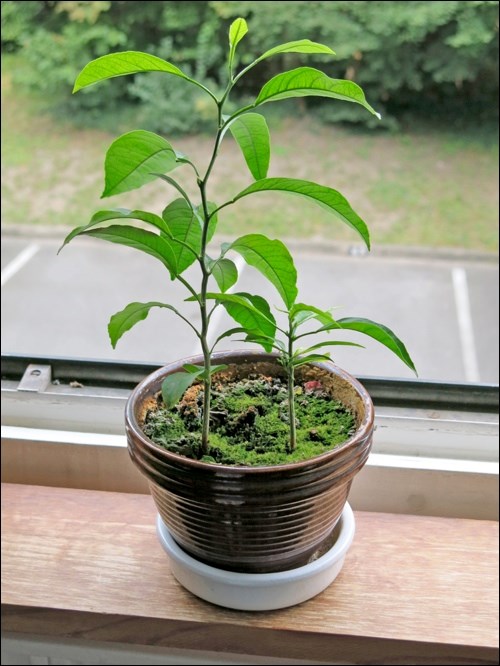Kitchens tend to be busy places during the winter. It’s also the time of year when we’re most apt to savour the exotic. What doesn’t go into the compote need not end up in the compost. Kitchen propagation with kids can be the pits, as well as an opportune learning experience.
Once you’ve prepared your guacamole, wash and dry the large avocado seed. Plant it with the pointed end poking up through the soil. The soil should be kept moderately moist without being overly wet, but never be allowed to dry out. You probably won’t get the medium-size tree native to South and Central America, but you should be able to produce a respectable houseplant.
Place the container in bright light, but out of direct sun, until the roots and shoots emerge. Be patient, this may take a few months. Then move it to full sun. To encourage branching, pinch out the central stem when the plant is about 15 centimetres high. Expect fairly rapid growth from this point on.
Mangoes, large trees native to India, are grown in a similar manner to avocados but can be more difficult. Plant the seed with the eye or bud facing up, just covering it with loose soil. Keep it warm and moist. The young leaves may be red but will change to green on maturity.
Sweet potatoes have long been cultivated in Central America. First, wash it off thoroughly to remove any growth inhibitors that may have been applied to keep them from sprouting in the grocery store. Plant in soil with half of it submerged. Place it in full sun. Roots and shoots will develop into a luxurious vine and it will continue to grow until it has exhausted the resources of the tuber. At that point, the new shoots can be used as cuttings, rooting them in sand and then afterwards replanting them in a soil mix.
Pineapples are members of the large tropical bromeliad family, originating in South America and the West Indies. Select a pineapple that is relatively large and with the freshest crown of leaves. Remove the top (including the green leaves) together with about an inch of the fruit, trimming away the soft sweet parts and leaving the hard stringy tissue. Allow the cut surface to dry for a few days to form a callus layer to prevent decay. Plant the top in sand, keeping it evenly moist but not overly wet. Move it to a well-drained soil mix in full sun once it has rooted.
Oranges, lemons, grapefruit and other citrus species can also be grown from seed, sowing them about two centimeters deep. I stuck some in a large pot in which a mature fig tree was already growing and simply forgot about them. Expect germination within six weeks. They like a rich soil in a deep pot in full sun but seem to handle benign neglect very well. They’ll grow into large shrubs with shiny leaves.
Other plants you can try to grow include papaya, ginger root, date and taro.
Besides the hands-on experience, these projects can involve a trip to your local library [or simply ask Mr. Google] to find out more about these plants and their native habitats. But don’t expect your labour to bear fruit. These plants seldom produce indoors unless provided with cross-pollination and/or conservatory-like conditions.
Sara is the author of numerous gardening books, among them the revised Creating the Prairie Xeriscape. And with Hugh Skinner: Gardening Naturally; Trees and Shrubs for the Prairies, and Groundcovers & Vines for the Prairies. Expect Fruit for Northern Gardens with Bob Bors in November, 2017.
— This column is provided courtesy of the Saskatchewan Perennial Society (SPS; www.saskperennial.ca; hortscene@yahoo.com; www.facebook.com/saskperennial). Check out our Bulletin Board or Calendar for upcoming garden information sessions, workshops, tours and other events: Feb. 22, 7:30 p.m.; SPS AGM followed by a video presentation - The Giving Garden - Kingsbrae Gardens in St Andrews, N.B.



